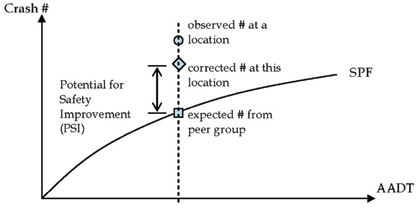U.S. Department of Transportation
Federal Highway Administration
1200 New Jersey Avenue, SE
Washington, DC 20590
202-366-4000
| << Funding Goals for Proactive Improvements – Minnesota | HSIP Project Identification | Level of Service of Safety and Diagnostic Analysis – Colorado >> |
Best for printing: [PDF] (1.9 MB)
To view PDF files, you can use the Acrobat® Reader®.
While the development of SafetyAnalyst and the Highway Safety Manual was still underway, Illinois decided to incorporate a new analysis technique to assist the state in moving forward with the implementation of SafetyAnalyst. Within a year, the Illinois Department of Transportation (IDOT), with the assistance of the University of Illinois, developed safety performance functions (SPF) for state routes and intersections throughout the state using the Empirical Bayes (EB) method. The SPFs have been used in the HSIP network screening process since 2008 to identify potential locations for safety improvement projects.
SPF equations were developed for 12 peer groups of roadway segments (e.g., rural two-lane highway, rural multilane undivided highway, rural multilane divided highway, etc.) and eight peer groups for intersections (e.g., rural minor leg stop control, rural all-way stop control, rural signalized, etc.). The SPFs are used in the network screening process to calculate a Potential for Safety Improvement (PSI) for all locations. The PSI is the difference between the corrected crash frequency (calculated using the EB method) and the expected crash experience (based on the SPF) for a given traffic volume within the peer group.
Since the focus of the HSIP is to reduce fatalities and serious injuries, the PSI calculation is weighted to emphasize the most severe crashes. The weighted PSI calculations are then ranked in ascending order by location and peer group to identify locations with the greatest safety need or highest PSI value. Once the sites with the greatest potential for safety improvement are identified, the IDOT Districts review the locations and make recommendations for improvement. Candidate HSIP projects on the state roadway system are selected by the District’s Safety Committee and submitted to the Bureau of Safety Engineering.
When the SPFs were originally developed, there was not enough data to develop SPFs for the local roadway system. Illinois has been expanding the crash database for local roadways and, in the near future, the state will begin discussions about the development of SPFs for local roadways, as well as updating the existing SPFs for state roadways. Currently, local roadways are evaluated using an aggregate level analysis to identify potential safety issues (e.g., counties with overrepresentation of a particular crash type, crash severity, behavioral issue, etc.). Local agencies can submit safety improvement projects to the State Safety Committee for funding consideration through the Local Road Program component of the HSIP.

Incorporating SPFs into the network screening process for safety improvement projects has led to several positive outcomes. Although other factors may involved, Illinois has seen a significant reduction in fatalities. In 2009, Illinois had the lowest number of fatalities since 1921. Transportation professionals are embracing the analysis results and making data-driven safety decisions. Using SPFs has helped shift the focus of the state’s program away from the urban, densely populated areas and provided a broader focus for safety projects, including low-cost safety improvements or systemic improvements that may not have been identified using previous analysis methods. Engineers throughout the state have become more familiar and comfortable with the use of SPFs through the state’s efforts, leading to a greater acceptance of SPFs and appreciation for improved quantitative data.
Roseanne Nance
Illinois Department of Transportation
217-785-5875
nancer@dot.il.gov
| << Funding Goals for Proactive Improvements – Minnesota | HSIP Project Identification | Level of Service of Safety and Diagnostic Analysis – Colorado >> |
